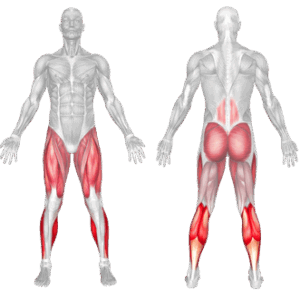Overview
The Squat Hold Calf Raise is a hybrid lower body exercise that combines an isometric squat hold with dynamic calf raises. This dual-action movement strengthens the gastrocnemius and soleus muscles while simultaneously engaging the quads, glutes, and core. It is a bodyweight exercise ideal for developing muscle endurance, balance, and lower-body stability without requiring equipment.
This compound movement is often used in athletic conditioning, functional fitness, and mobility training.
How to Perform the Squat Hold Calf Raise

Starting Position: Stand with feet shoulder-width apart and arms extended forward or clasped together at chest height for balance.
Descend Into Squat: Lower yourself into a parallel squat, keeping knees in line with toes, back straight, and chest upright.
Establish the Hold: Maintain the squat position—your thighs should be parallel to the floor or as low as comfortable.
Raise Your Heels: While holding the squat, lift your heels off the ground by pressing through the balls of your feet.
Pause and Lower: Hold at the top briefly, then lower your heels back down under control.
Repeat: Perform multiple calf raises while maintaining the squat position for the entire set.
Tips for Proper Form
Keep your knees aligned with your toes—avoid inward collapse (valgus).
Maintain an upright torso with your core engaged throughout the squat hold.
Focus on balance by keeping your gaze forward and your arms out for stability.
Control the heel raise with deliberate movement and full calf contraction.
Do not bounce—perform each rep with intention and control.
Common Mistakes
Breaking the squat form: Rising or letting the hips drift upward defeats the purpose of the isometric hold.
Not lowering heels fully: Shortening the range of motion reduces calf activation.
Knees caving in: Leads to joint strain and reduced effectiveness—keep them tracked outward.
Holding breath: Proper breathing supports stability and endurance.
Lack of balance: Rushing the reps or poor foot placement can cause wobbling or ineffective movement.
Benefits of the Squat Hold Calf Raise
Strengthens the calves: Directly targets the gastrocnemius and soleus through high-tension heel raises.
Improves isometric squat strength: Holding the squat trains quads, glutes, and hip stabilizers under prolonged tension.
Enhances ankle stability and mobility: Promotes ankle control, balance, and range of motion—crucial for sports and daily activities.
Boosts lower-body endurance: Trains your muscles to resist fatigue, improving overall performance.
No equipment needed: Can be done anywhere—perfect for home workouts, warm-ups, or travel routines.
Improves neuromuscular coordination: Challenges muscle control during static and dynamic movement simultaneously.
Reinforces proper squat mechanics: Promotes alignment, control, and lower-limb muscle synergy.
How to Incorporate Into Your Routine
- For Beginners: Perform 2–3 sets of 8–10 calf raises while holding a shallow squat. Focus on form and balance.
- For Muscle Endurance: Do 3–4 sets of 15–20 reps with short rest (30–45 seconds) to build stamina and burn.
- For Hypertrophy (Bodyweight Only): Slow the tempo, hold the squat deeper, and perform 12–15 reps per set.
- For Athletic Performance: Combine with jump squats or sprint drills in a circuit to boost explosiveness and foot strength.
- For Mobility and Prehab: Use this as a low-load warm-up or rehab drill to improve ankle control and joint alignment.
- For Fatigue Resistance: Add this to the end of your leg day as a burnout finisher to challenge muscle endurance under fatigue.
Squat Hold Calf Raise: Muscles Worked

Frequently Asked Questions
How low should I squat during this exercise?
Lower to parallel or just below, depending on your mobility. Ensure your form is solid before increasing depth.
Should I wear shoes or go barefoot?
Flat training shoes or barefoot can improve foot control and feedback, especially on stable surfaces.
Can I hold weights during this exercise?
Yes, once you master bodyweight form, you can hold dumbbells or a kettlebell to increase difficulty.
How many calf raises should I perform per hold?
Aim for 10–20 reps per squat hold, depending on your goal and fatigue level.
Can I include this in leg day?
Absolutely. It’s a great accessory or finisher exercise that complements squats, lunges, and deadlifts.
